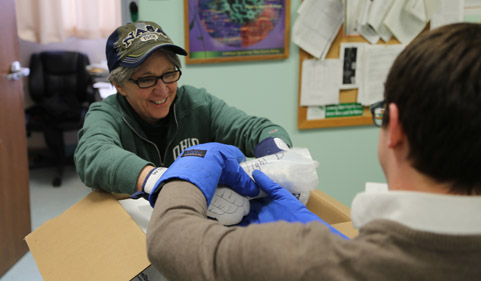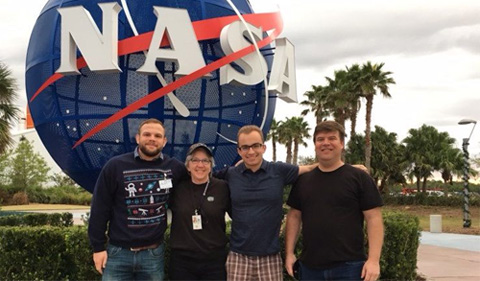
In 2015, Sarah Wyatt and Colin Kruse unpack the frozen samples that flew on their first experiment on the International Space Station.
NASA announced on Aug. 7 that Dr. Sarah Wyatt received an award for plant biology studies, with another spaceflight to the International Space Station in her lab’s future as the United States prepares for missions to the Moon and Mars.
Wyatt’s was one of 15 grants “for new space biology research designed to help the agency achieve its goals under the Artemis lunar exploration program. Teams of investigators will use state-of-the-art genetic and other biological techniques to explore how life adapts and changes during spaceflight, and the results could help support human exploration of the Moon, and ultimately, Mars,” NASA announced.
“Plants will be a crucial component for astronaut health and well-being during any long-distance spaceflight or colonization mission,” Wyatt said. “They are a source of food, for replenishing water and purifying air as well as physiological and psychological comfort. The challenge is to understand how plants respond to the spaceflight environment to enable plants to thrive in potentially hostile environments.”
Wyatt is Professor of Environmental & Plant Biology and Director of Molecular & Cellular Biology at Ohio University. And this is not her first trip to space. Graduate and undergraduate students in her lab have presented their research at conferences around the world.

From left, OHIO grad student Alex Meyers, OHIO Professor of Environmental and Plant Biology Sarah Wyatt, technician Nathan Madonich, and Ohio Wesleyan Professor Chris Wolverton.
- After about 140 days on the International Space Station (and more than 2,000 trips around the Earth), Alexander Meyers’ plants caught a ride home on the Dragon capsule in May 2018.
- Watch: Wyatt’s Science Cafe on Plant Gravity Perception: from Earth to International Space Station.
- Seedlings Germinated on Space Station Arrive in Athens in February 2015.
Plants don’t grow “up” because they are attracted to sunlight. They grow up because they are responding to gravity. The Wyatt lab is studying the signal-induced gravitropic response in Arabidopsis thaliana.
NASA Looks to Establish Human Presence on Moon by 2028
“Called to return to the Moon within five years, NASA’s lunar exploration plans are based on a two-phase approach: the first is focused on speed – landing on the Moon by 2024 – while the second will establish a sustained human lunar presence by 2028. The agency will use what we learn on the Moon to prepare for the next giant leap – sending astronauts to Mars,” NASA said.
“Selected microbiology investigations will study whether changes in bacteria, fungi, and viruses are likely to affect how they interact with crew and material surroundings aboard the International Space Station, with an emphasis on likelihood to cause infections and microbial evolution,” according to the announcement about the $9 million to be awarded in fiscal years 2020-2023.
“The plant studies will determine important characteristics of plants relevant to space-farming methods for exploration missions. Topics for investigation include how interactions between microbes in soil and on plants change in spaceflight and changes in plant disease defense mechanisms.” Read more about the NASA grants.
Abstract for Wyatt Lab Grant: As technologies have advanced for global gene expression, transcriptome level research has become an integral part of experiments and provides knowledge of gene expression resulting from the conditions of spaceflight. Steady state transcript abundance quantified by RNASeq is frequently used as measure of gene expression with the implicit assumption that transcriptional changes upon a treatment (such as a stress) are indicative of the downstream response. However, changes in mRNA abundance do not necessarily lead to corresponding changes in protein, and transcript and protein abundance are not highly correlated. The data from spaceflight experiments BRIC20 (PI Wyatt) and Plant Signaling (PI Perera) suggest that post-transcriptional regulation plays an integral role in gene expression differences between spaceflight and ground controls. The differential expression, abundance and phosphorylation of translational machinery in spaceflight leads to the obvious questions: What genes are being post transcriptionally regulated and by what mechanism(s)? To answer these questions, PIs Wyatt and Perera plan to combine expertise and resources to generate compatible multi-omics datasets and provide a comprehensive picture of transcriptional and post transcriptional regulation. This integrated approach will help answer fundamental questions regarding plant adaptation to spaceflight and this proposal is aligned with sub-topic PL-A of Appendix B. The novel datasets and analyses will address questions outlined in Research Emphasis 2 of the Space Biology Science Plan 2016-2025, specifically “(a) Answer basic questions about how plants respond to changes in gravity and other environmental factors associated with spaceflight. And (b) Build on past plant research to provide a better understanding of physiological responses of plants to spaceflight, providing new knowledge that can facilitate the development of a bioregenerative life support system.” Analyses will also address Research Emphasis 4: molecular and cellular biology, specifically “(a) Studies designed to determine how spaceflight alters gene expression at the transcriptomic, metabolomics and proteomics levels in the different tissues or cell types within the same organism, and how these changes impact the organism’s overall health during space travel”.



















Comments